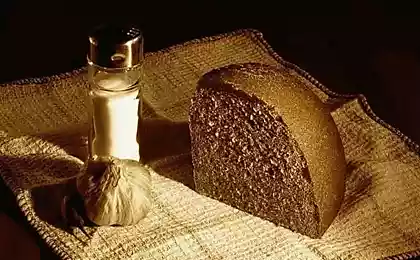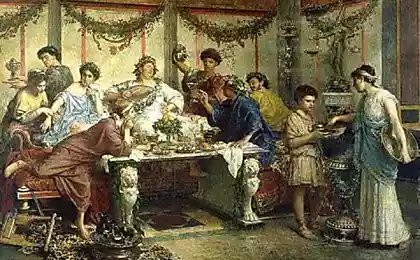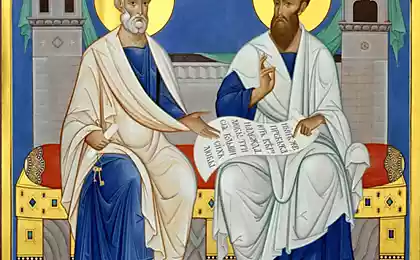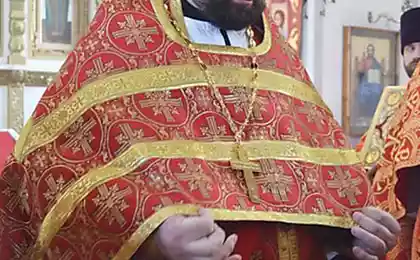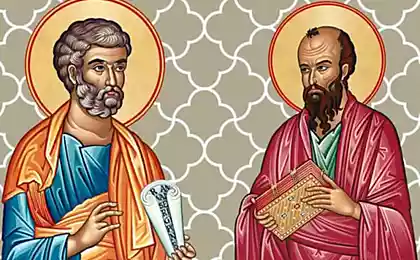470
7 LENTEN TRADITIONS
So began the Great post. It lasts forty days, which point follows on them seven days of Holy week. Of course, we all know the order of worship and a series of weeks. But other than "official" institutions, there are more and more established over the centuries. Most of them is non-religious in nature, rather domestic. They help us a little easier to go through the difficult time 47-day fast and a little to brighten his sad day.
The tradition of the first. Mushroom marketby Our ancestors, who were not building, they preferred to purchase products from for a long time and at one time. The purchase of the post was the most important ritual, an integral part of the post. First week post set aside for just such purchases. Thousands of people rushed to the markets where the beginning of the post took a myriad of diet food: raw, pickled, pickled, dried, cured, salted vegetables, berries, cereals, and of course "wild beef" and mushrooms. Purchased each from his abundance, the rich people took the goods carts.
It's now fast food is more expensive, than perilous, and pickled cabbage with cranberries Yes pickles were worth pennies. The basis for a Lenten table were mushroom dishes, so lean markets called mushroom. In the market to sell mushrooms — eateries intended for treats "to go", and pohrebnyak, which was stew, and dried and salted. Mushrooms preparing all kinds of soups, eggs, goulash, mince for pies, additives for cereal, soup and many other dishes — almost everything. Is that the desserts of the mushrooms didn't cook.
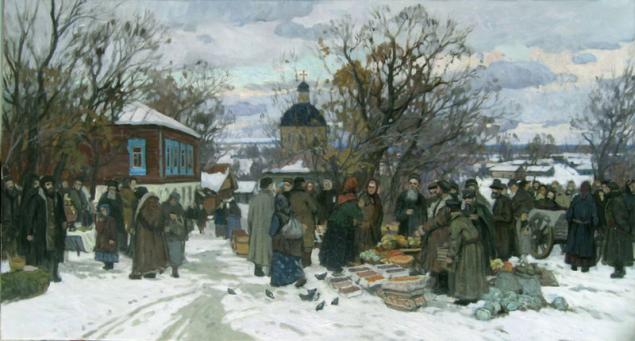
"Lean market", V. A. Kapnek
Tradition second. Lenten biscuits — "crosses"It is baked from lean dough with candied fruit, raisins or almonds in the veneration of the cross Sunday of the week. As you can tell from the title, liver give a cruciform shape. Often raisins or candied fruits on perekladnyh made "gwozdecky" and the little crossbars poured sugar icing. "Crosses" was the first treat to this day. It was believed that you should eat them on an empty stomach and drink the Holy water — it was supposed to improve health. As was the custom of the form is removed from the furnace crosses to learn their fate: if the battered cross smooth, without flaws, was a success and well-being. If the cross was cracked, swelled, or worse — collapsed, then expect trouble and all kinds of hardships.
The third tradition. "Lark""Lark" is also a kind of vegetable cookies, the preparation of which is associated with the memory of the forty martyrs of Sebaste, which is celebrated on March 22, new style. Over time, the name of the holiday "forty martyrs" gradually transformed into "magpie" and in the popular mind connected with the expectation of spring and the return of migratory birds. Therefore, cookies baked from a yeast or dough, giving it the shape of a bird with eyes from raisins or other berries. It was believed that on this day winter finally goes away and spring arrives first bird — a lark.
In some provinces the cookies are called "waders", in some "sparrows", and in the North — "teary". "Teary" of all Lenten biscuits had the mysterious kind: they were made of bundles of dough that were twisted together, getting the intricate patterns that are similar to ancient drawings of the sun, animals, religious symbols.
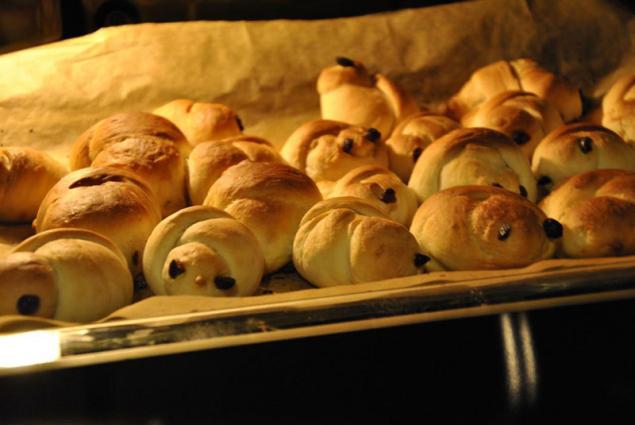
The number of "lark" was to be not less than 40. "Larks" were mostly children's treat. Sweet birds were distributed to the kids, and they skewer them on a long thin stick, ran with them through the village and touted spring songs-stoneflies. Plenty of oncoming, the children ate birds, showing off, one is tastier Yes beautiful mother bakes.
The tradition of the fourth. Cookies a "Ladder"of these biscuits, as you may have guessed, bake on Sunday of the fourth week of lent, marking thus the memory of St. John Climacus. For this cookie is used sand lean dough. Of course, the food should have the form of a ladder. Often cookies were formed from the two wire harnesses connected by crossbars, but in some areas, "stairs" was performed in the form of a long thin rolled tortillas, which sculpted the little crossbars.
The number of beams in such a edible ladder could be different, but symbolic: 7 — because it was believed that there are seven "heavens", 12 — the number of apostles, 20 — the number of trials and so on. Ladders with a large number of stages could be in the form not cookie cutter, and the construction of two long plaits of dough, between which as the rails were laid small cakes. Unlike "the lark", "stairs" left to themselves: part was given to the temple for the clergy, and the rest were instructed to give to the poor.
The tradition of the fifth. Palm SundayIn the middle East, this holiday is called Palm Sunday because on this day remember the entry of the Lord Jesus Christ into Jerusalem and the solemn meeting, which gave Him the townspeople, out on the road with palm branches in their hands. As there are palm trees everywhere, not growing, and the holiday falls on early spring, and the only plant which by this time is showing signs of life, is willow, we have taken a day of holiday to be in the temple with branches of the willows.
Now, each comes with its bunch before, usually willow cut carts and the evening was brought to a Church that after the consecration was given to the faithful. Sanctified branches took care of with care, as the people's trust gave them more "power". A bunch of consecrated willow was obatala, the corners of the house to drive away evil spirits, on St. George's day (St. George's day) has traditionally been the first cattle to pasture, and cows with goats Yes sheep drove on this day consecrated verboczky. In some areas, it was decided to put a willow twig in the hands of the deceased, to "in the light of the Lord met". If you were in trouble — a cow or a horse was sick, he gave them to drink water that has kept the consecrated willow.
In many provinces was made a consecrated willow whip each other, especially the children, saying thus: "willow — whip, beat to tears. Be healthy, like willow." There was also a belief according to which the barren woman was supposed to eat a kidney from the consecrated willow branches, and then speed it was supposed to be a pregnancy. The bars tried to keep until the next palm, then they changed to the new and the old burned in the furnace.
The tradition of the sixth. Thursday's candleon Holy Thursday in the afternoon, in the temples read the twelve Gospels of the passion of Christ. The twelve passages from the Gospels that tell about the pain that moved the Savior after his arrest until his crucifixion. According to the custom of listening to this reading with a lighted candle, so this candle is also called the Evangelical fire, "terrible" (passion) candles. To do this, tried to buy the great candle to have enough for all of the services, and then to be able to convey to the house. Twinkle cherished with the utmost care, often in order to keep it, a candle was placed in a scraped-out pumpkin.
Entering the house, with a candle and walked around all the rooms, all rooms, all corners and over door and window openings it soot painted crosses, to evil is not come into the house and not nasty. It was believed that if the candle is not extinguished in the wind, and its light was able to go around the house, family well-being awaits this year, sickness and sorrow will give her a pass.
Tradition seven. Maundy ThursdayThis is the second national title Passion Thursday. On this day, people sought to cleanse the soul by confession, and the body bath. Hostess after the Liturgy has started spring cleaning in the house: washing Windows and floors, swept all the cobwebs from the corners, wash all the dishes, made a clean tablecloth on the table, changed the towels on icons with a lean on the festive, decorated with icons of red artificial flowers. In the evening the whole family went to the bath how to warm up, to "wash away sins". This day is traditionally finished final preparations for Easter: baked cakes, dyed eggs, did an oil and sheep cheese Easter. And after finishing all the household chores, engage in two of the most intense of the day: Good Friday and Holy Saturday, in the prayer zeal to celebrate a Bright Christmas day.
published
P. S. And remember, only by changing their consumption — together we change the world! ©
Join us in Facebook , Vkontakte, Odnoklassniki
Source: www.matrony.ru/7-velikopostnyih-traditsiy/
The tradition of the first. Mushroom marketby Our ancestors, who were not building, they preferred to purchase products from for a long time and at one time. The purchase of the post was the most important ritual, an integral part of the post. First week post set aside for just such purchases. Thousands of people rushed to the markets where the beginning of the post took a myriad of diet food: raw, pickled, pickled, dried, cured, salted vegetables, berries, cereals, and of course "wild beef" and mushrooms. Purchased each from his abundance, the rich people took the goods carts.
It's now fast food is more expensive, than perilous, and pickled cabbage with cranberries Yes pickles were worth pennies. The basis for a Lenten table were mushroom dishes, so lean markets called mushroom. In the market to sell mushrooms — eateries intended for treats "to go", and pohrebnyak, which was stew, and dried and salted. Mushrooms preparing all kinds of soups, eggs, goulash, mince for pies, additives for cereal, soup and many other dishes — almost everything. Is that the desserts of the mushrooms didn't cook.

"Lean market", V. A. Kapnek
Tradition second. Lenten biscuits — "crosses"It is baked from lean dough with candied fruit, raisins or almonds in the veneration of the cross Sunday of the week. As you can tell from the title, liver give a cruciform shape. Often raisins or candied fruits on perekladnyh made "gwozdecky" and the little crossbars poured sugar icing. "Crosses" was the first treat to this day. It was believed that you should eat them on an empty stomach and drink the Holy water — it was supposed to improve health. As was the custom of the form is removed from the furnace crosses to learn their fate: if the battered cross smooth, without flaws, was a success and well-being. If the cross was cracked, swelled, or worse — collapsed, then expect trouble and all kinds of hardships.
The third tradition. "Lark""Lark" is also a kind of vegetable cookies, the preparation of which is associated with the memory of the forty martyrs of Sebaste, which is celebrated on March 22, new style. Over time, the name of the holiday "forty martyrs" gradually transformed into "magpie" and in the popular mind connected with the expectation of spring and the return of migratory birds. Therefore, cookies baked from a yeast or dough, giving it the shape of a bird with eyes from raisins or other berries. It was believed that on this day winter finally goes away and spring arrives first bird — a lark.
In some provinces the cookies are called "waders", in some "sparrows", and in the North — "teary". "Teary" of all Lenten biscuits had the mysterious kind: they were made of bundles of dough that were twisted together, getting the intricate patterns that are similar to ancient drawings of the sun, animals, religious symbols.

The number of "lark" was to be not less than 40. "Larks" were mostly children's treat. Sweet birds were distributed to the kids, and they skewer them on a long thin stick, ran with them through the village and touted spring songs-stoneflies. Plenty of oncoming, the children ate birds, showing off, one is tastier Yes beautiful mother bakes.
The tradition of the fourth. Cookies a "Ladder"of these biscuits, as you may have guessed, bake on Sunday of the fourth week of lent, marking thus the memory of St. John Climacus. For this cookie is used sand lean dough. Of course, the food should have the form of a ladder. Often cookies were formed from the two wire harnesses connected by crossbars, but in some areas, "stairs" was performed in the form of a long thin rolled tortillas, which sculpted the little crossbars.
The number of beams in such a edible ladder could be different, but symbolic: 7 — because it was believed that there are seven "heavens", 12 — the number of apostles, 20 — the number of trials and so on. Ladders with a large number of stages could be in the form not cookie cutter, and the construction of two long plaits of dough, between which as the rails were laid small cakes. Unlike "the lark", "stairs" left to themselves: part was given to the temple for the clergy, and the rest were instructed to give to the poor.
The tradition of the fifth. Palm SundayIn the middle East, this holiday is called Palm Sunday because on this day remember the entry of the Lord Jesus Christ into Jerusalem and the solemn meeting, which gave Him the townspeople, out on the road with palm branches in their hands. As there are palm trees everywhere, not growing, and the holiday falls on early spring, and the only plant which by this time is showing signs of life, is willow, we have taken a day of holiday to be in the temple with branches of the willows.
Now, each comes with its bunch before, usually willow cut carts and the evening was brought to a Church that after the consecration was given to the faithful. Sanctified branches took care of with care, as the people's trust gave them more "power". A bunch of consecrated willow was obatala, the corners of the house to drive away evil spirits, on St. George's day (St. George's day) has traditionally been the first cattle to pasture, and cows with goats Yes sheep drove on this day consecrated verboczky. In some areas, it was decided to put a willow twig in the hands of the deceased, to "in the light of the Lord met". If you were in trouble — a cow or a horse was sick, he gave them to drink water that has kept the consecrated willow.
In many provinces was made a consecrated willow whip each other, especially the children, saying thus: "willow — whip, beat to tears. Be healthy, like willow." There was also a belief according to which the barren woman was supposed to eat a kidney from the consecrated willow branches, and then speed it was supposed to be a pregnancy. The bars tried to keep until the next palm, then they changed to the new and the old burned in the furnace.
The tradition of the sixth. Thursday's candleon Holy Thursday in the afternoon, in the temples read the twelve Gospels of the passion of Christ. The twelve passages from the Gospels that tell about the pain that moved the Savior after his arrest until his crucifixion. According to the custom of listening to this reading with a lighted candle, so this candle is also called the Evangelical fire, "terrible" (passion) candles. To do this, tried to buy the great candle to have enough for all of the services, and then to be able to convey to the house. Twinkle cherished with the utmost care, often in order to keep it, a candle was placed in a scraped-out pumpkin.
Entering the house, with a candle and walked around all the rooms, all rooms, all corners and over door and window openings it soot painted crosses, to evil is not come into the house and not nasty. It was believed that if the candle is not extinguished in the wind, and its light was able to go around the house, family well-being awaits this year, sickness and sorrow will give her a pass.
Tradition seven. Maundy ThursdayThis is the second national title Passion Thursday. On this day, people sought to cleanse the soul by confession, and the body bath. Hostess after the Liturgy has started spring cleaning in the house: washing Windows and floors, swept all the cobwebs from the corners, wash all the dishes, made a clean tablecloth on the table, changed the towels on icons with a lean on the festive, decorated with icons of red artificial flowers. In the evening the whole family went to the bath how to warm up, to "wash away sins". This day is traditionally finished final preparations for Easter: baked cakes, dyed eggs, did an oil and sheep cheese Easter. And after finishing all the household chores, engage in two of the most intense of the day: Good Friday and Holy Saturday, in the prayer zeal to celebrate a Bright Christmas day.
published
P. S. And remember, only by changing their consumption — together we change the world! ©
Join us in Facebook , Vkontakte, Odnoklassniki
Source: www.matrony.ru/7-velikopostnyih-traditsiy/
